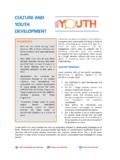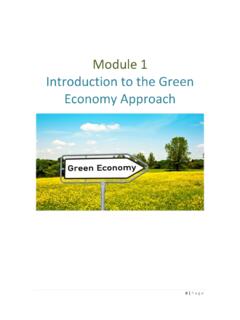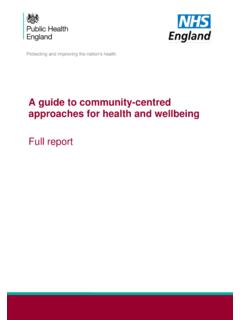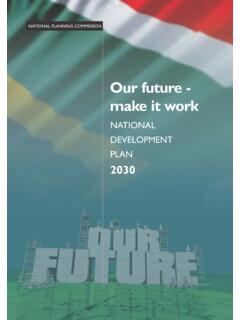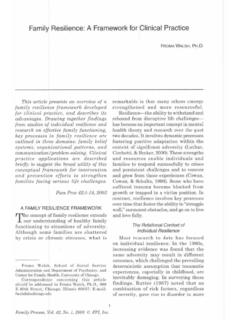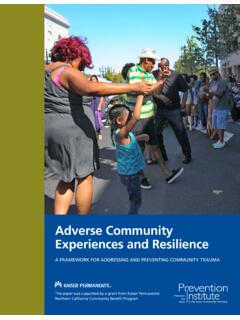Transcription of Community capacity building: fostering economic and …
1 Please cite this paper as: OECD/Noya A. Clarence E., Community capacity building : fostering economic and social resilience . Project outline and proposed methodology , 26-27 November 2009, working document, CFE/LEED, OECD, . OECD LEED Programme Community capacity building : fostering economic and social resilience PROJECT OUTLINE AND PROPOSED METHODOLOGY Antonella Noya and Emma Clarence CFE/LEED(2009)21 2 TABLE OF CONTENTS Introduction .. 3 Context .. 3 Some key lessons for policy makers .. 4 Some areas to be explored .. 7 Methodology: Project outline and review framework .. 8 Objectives .. 8 Detailed stages of the project .. 8 Timing .. 10 Budget .. 10 Bibliography .. 11 Figures Figure 1. Community capacity building - Local Multiplier Effect (combining social and economic factors) .. 5 Boxes Box 1. Gellideg Foundation Group Gellideg, Wales (UK) .. 6 Box 2. Palmas Bank Brazil .. 7 Box 3. Brief overview of review activities.
2 10 This note presents the proposed methodology for a project on Community capacity building : fostering economic and social resilience [CFE/LEED(2009)21], prepared as a follow-up to the discussion held at the 54th session of the LEED Directing Committee in May 2009 on the draft report on Community capacity building [CFE/LEED(2009)10]. CFE/LEED(2009)21 3 Introduction 1. Community capacity building (CCB) focuses on enabling all members of the Community , including the poorest and the most disadvantaged, to develop skills and competencies so as to take greater control of their own lives and also contributes to inclusive local development. Not only can communities be more cohesive but they can also be more resilient and better placed to confront economic and social challenges. Meaningful and effective Community capacity building can be stimulated and fostered by national and local governments, and by the capacity which communities have already developed, so that power becomes increasingly embedded within them.
3 2. CCB has developed as a concept because of the need for strategies to address major social and economic decline in towns, cities and regions experiencing significant economic change and the consequences of deep-seated and long term worklessness and benefits dependency. 3. Following the OECD study on Community capacity building (presented and approved at the 52nd LEED Directing Committee and published in 2009 as Community capacity building : Creating a Better Future Together), further ideas are presented here as to how to extend and embed its analysis into a broader programme of work. 4. This document presents, in detail, a project of work on Community capacity building : fostering economic and social resilience , its methodology, objectives and outputs. The specific focus of the project is to enhance local and national governments capacity to design and implement strategies to build, rebuild and sustain Community capacity especially in deprived communities and in towns, cities and regions suffering from economic decline, worklessness and benefits dependency.
4 To this end the project will identify the current approaches to CCB, the obstacles to designing effective CCB strategies, together with the drivers to more effective empowerment at local level. Emphasis will also be put on the skills and institutions needed in a Community to actively build or rebuild local social and economic life. Recommendations will be developed and international examples of good practice ( learning models ) will be provided. Context 5. Today the developed world is faced with a new wave of industrial change remaining industrial centres in Western Europe and North America are threatened with the same decline experienced by similar towns and cities twenty to thirty years ago. The financial crisis and global recession will see, and are already witnessing, restructured companies closing large industrial facilities and other major employment sites; car plants are likely to close in cities in the US, France, Belgium, Italy, Spain, Portugal, Germany and the UK; major steel production centres are under threat in the UK, Belgium, Germany and Scandinavia.
5 These developments are often combined with steady economic decline. Many towns, cities and regions are still looking for new types of economic purpose in the future; new specialisms, greater diversification, new forms of entrepreneurship. There is a danger that the most fragile locations in the developed and developing world are bearing a disproportionate brunt of the global slowdown. Unemployment and business closures are rising fastest in those areas of the advanced world where worklessness and low business activity were already problematic. Furthermore, localities emerging from political conflict and division often remain fragile for generations. Poverty, exclusion and worklessness are inherent in affected communities and exacerbated at times of economic downturn. 6. Such realities are a central part of the rationale for continuing and expanding the work on Community capacity building . There are many areas (from the neighbourhood to the country level) that require economic and social strategies that enable them to build, or to continue rebuilding local CFE/LEED(2009)21 4 communities and economies.
6 Indeed, for some years to come it will be necessary to preserve Community capacity and assets in order to maintain social and economic conditions. At the same time, there are also places where capacity building strategies can help to build economic and social assets during longer term growth phases. By building capacity , communities will be in a better position to meet the challenges of the current crisis and to be more resilient to the next economic downturn. Better jobs, increased levels of entrepreneurship, positive social capital indicators, business performance and sustainability are all potential indicators of the resilience which increased Community capacity can bring to local areas. 7. There are major tensions between national, regional and local governments to develop strategies that build, rebuild and preserve economic and social infrastructure in communities. Balancing national and local priorities is always difficult but in the present economic and political circumstances it is an even greater challenge.
7 However, there is a widespread appetite amongst governments to act decisively at both local and national levels in the current crisis and there is a need to find an appropriate balance between these sometimes competing objectives. The priorities at all spatial levels are to build Community capacity , to rebuild capacity in deprived cities and regions, and to sustain such activity in difficult economic times. Jobs, entrepreneurship and business performance are key tangible areas to which Community capacity building can contribute, and this is accompanied by more intangible factors including increased social capital and social cohesion. Some key lessons for policy makers 8. From the work already undertaken by OECD LEED (Noya et al. 2009; Noya, 2009; Noya and Clarence, 2007) a number of key lessons for policy makers can be identified. 9. Firstly, policy makers should specifically construct services and strategies that are aimed at stimulating enterprise, social capital and Community capacity in deprived areas.
8 It is important that in doing so, policy makers should pursue as broad an approach as possible with concurrent strategies aimed at stimulating capacity and activity at the personal and household level, in the public and private sectors and through the third sector. 10. Secondly, policy makers should resist the conflation of the social economy and capacity building with just one or two sectors in a Community . capacity building and the stimulation of higher levels of social capital and networks will be best achieved through an understanding of the broader base of activities and organisations that create and contribute to the most positive forms of social capital and Community capacity . 11. Thirdly, policy makers should maximise the inter-relationships between the social economy (and Community capacity ) and other sectors, as well as following policies that boost either private sector entrepreneurship or the third sector in isolation.
9 Vertical approaches in policymaking and service delivery must be complemented with horizontal interventions and strategies. 12. Fourthly, policy makers should ensure that support for example, information, mentoring and finance is focused on a broad range of people, services and agencies. Support for organisations that lock in economic and social benefits to a particular Community is vital. Such organisations might include local co-operatives, credit unions, time banks and other third sector or social economy organisations as well as private sector entrepreneurs and small businesses. 13. Fifthly, policy makers should create civic infrastructure capacity for well-being and spaces for social interaction and networks. Community and business spaces and social networks without obvious economic benefits should be part of a comprehensive approach to capacity building . Spaces for people and CFE/LEED(2009)21 5 groups to meet, for communities to come together are important aspects of all places and are conscious elements within the creation of new business locations, such as in Barcelona and Stockholm.
10 14. Sixthly, policy makers should understand that most decisions and support should be exercised within communities as much as is practically possible. social capital or Community capacity is less likely to be created or sustained from the outside. Ultimately, it is the Community and its residents that have the strongest understanding, ability and motivation to shape it for the better. 15. Practically, these measures will help to build stronger, more resilient communities with greater Community capacity and improved relationships between all sectors and individuals within a Community . These principles help to create the conditions through which new forms of social and economic activity might be generated within any given location. It also enables private sector employers to locate in an area and to build better, more economically and socially sustainable businesses in conjunction with local knowledge and networks.










